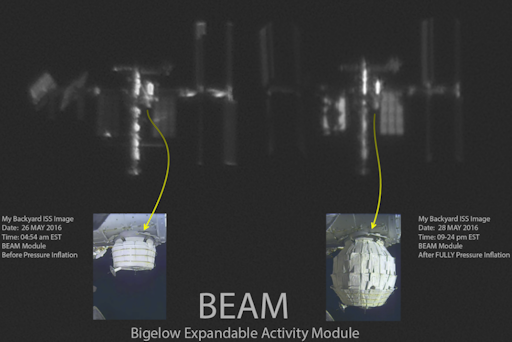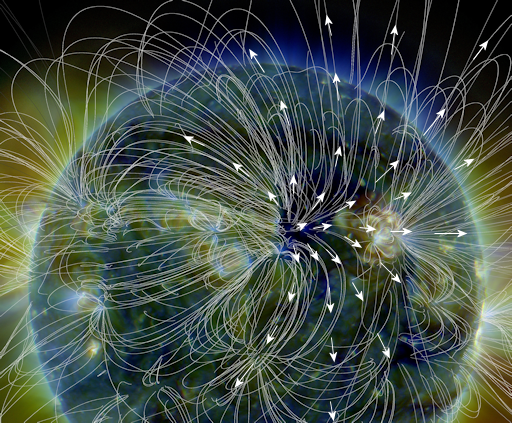It's waiting for you: The most successful Aurora Photo Tour on Earth! 100% success rate 4 years in a row and winner of the TripAdvisor Certificate of Excellence Award. Join LapplandMedia's aurora tours in Abisko, Swedish Lapland! | | | CLOSE ENCOUNTER WITH MARS:Today, May 30th, Mars and Earth have converged for their closest encounter in a decade. The two worlds are only 47 million miles apart. Look south after dark. The Red Planet is shining like a bright burnt-orange star in the constellation Scorpius: sky map. AMATEUR ASTRONOMER PHOTOGRAPHS BEAM: There's a new room on the International Space Station. NASA inflated it on Saturday. The Bigelow Expandable Activity Module (BEAM) was filled with air by astronaut Jeff Williams as the ISS flew over the south Pacific, kicking off an experiment to learn how inflatable habitats perform in a microgravity environment. "I think I am the first amateur astronomer to photograph BEAM from Earth," says Philip Smith, who sends these before-and-after images from Manorville, New York: 
"Using a backyard telescope, I tracked the ISS as it passed overhead on May 26th (before inflation) and May 28th (after)," says Smith. "The new addition was clearly visible in my images." "The Bigelow Aerospace-built BEAM is a prototype space habitat for future space stations, moon colonies and moon bases," he adds. "I am glad to be a small part of that history." BEAM will remain attached to station for a two-year test period. Astronauts will not occupy the new room, but they will enter from time to time and monitor its performance. For more information about BEAM, visit: www.nasa.gov/beam. Realtime Space Weather Photo Gallery CHANCE OF STORMS ON MEMORIAL DAY: NOAA forecasters estimate a 55% chance of minor G1-class geomagnetic storms on May 30th when Earth enters a high-speed stream solar wind flowing from this coronal hole: 
Coronal holes are places in the sun's atmosphere where the magnetic field opens up and allows solar wind to escape. When solar wind leaves the sun, it carries some of the sun's magnetic field with it to Earth. This is key: Magnetic fields in the emerging stream have a negative polarity ("negative Bz"). Such fields can pry open a crack in Earth's magnetosphere, allowing solar wind to pour in and fuel geomagnetic storms. High-latitude sky watchers should be alert for auroras on May 30th, especially in the southern hemisphere where darkening autumn skies favor visibility of faint lights. Aurora alerts: text, voice. Realtime Aurora Photo Gallery SPACE BEARS MAKE GOOD GRADUATION GIFTS: Around the USA, high school seniors are preparing to receive their diplomas. Nothing says "you're on your way up!" better than a graduation gift from the Edge of Space. On May 25th, the students of Earth to Sky Calculus flew a family of "graduation grizzlies" 27 km (90,000 feet) above Earth's surface: 
Outfitted with space helmets and a diploma, the intrepid Ursidae survived cosmic rays, ultra-low temperatures, and the near-vacuum of the stratosphere. For $49.95 you can have one of these bears along with a unique Graduation card showing the bears floating at the top of Earth's atmosphere. Buy one now. Sales of the bears support student space weather research. In fact, the bears pictured above were hitchhiking on a payload equipped with radiation sensors. We send the sensors to the stratosphere every week to monitor increasing levels of cosmic rays. Visit the Earth to Sky store to support this crowd-funded research. Realtime Space Weather Photo Gallery
Realtime Sprite Photo Gallery Realtime Noctilucent Cloud Photo Gallery
Realtime Comet Photo Gallery Every night, a network of NASA all-sky cameras scans the skies above the United States for meteoritic fireballs. Automated software maintained by NASA's Meteoroid Environment Office calculates their orbits, velocity, penetration depth in Earth's atmosphere and many other characteristics. Daily results are presented here on Spaceweather.com. On May. 30, 2016, the network reported 4 fireballs.
(4 sporadics)  In this diagram of the inner solar system, all of the fireball orbits intersect at a single point--Earth. The orbits are color-coded by velocity, from slow (red) to fast (blue). [Larger image] [movies] Potentially Hazardous Asteroids ( PHAs) are space rocks larger than approximately 100m that can come closer to Earth than 0.05 AU. None of the known PHAs is on a collision course with our planet, although astronomers are finding new ones all the time. On May 30, 2016 there were potentially hazardous asteroids. Notes: LD means "Lunar Distance." 1 LD = 384,401 km, the distance between Earth and the Moon. 1 LD also equals 0.00256 AU. MAG is the visual magnitude of the asteroid on the date of closest approach. | | Cosmic Rays in the Atmosphere | | Situation Report -- Oct. 30, 2015 | Stratospheric Radiation (+37o N) | | Cosmic ray levels are elevated (+6.1% above the Space Age median). The trend is flat. Cosmic ray levels have increased +0% in the past month. | | Sept. 06: 4.14 uSv/hr (414 uRad/hr) | | Sept. 12: 4.09 uSv/hr (409 uRad/hr) | | Sept. 23: 4.12 uSv/hr (412 uRad/hr) | | Sept. 25: 4.16 uSv/hr (416 uRad/hr) | | Sept. 27: 4.13 uSv/hr (413 uRad/hr) | | Oct. 11: 4.02 uSv/hr (402 uRad/hr) | | Oct. 22: 4.11 uSv/hr (411 uRad/hr) | These measurements are based on regular space weather balloon flights: learn more. Approximately once a week, Spaceweather.com and the students of Earth to Sky Calculus fly "space weather balloons" to the stratosphere over California. These balloons are equipped with radiation sensors that detect cosmic rays, a surprisingly "down to Earth" form of space weather. Cosmic rays can seed clouds, trigger lightning, and penetrate commercial airplanes. Our measurements show that someone flying back and forth across the continental USA, just once, can absorb as much ionizing radiation as 2 to 5 dental X-rays. For example, here is the data from a flight on Oct. 22, 2015: 
Radiation levels peak at the entrance to the stratosphere in a broad region called the "Pfotzer Maximum." This peak is named after physicist George Pfotzer who discovered it using balloons and Geiger tubes in the 1930s. Radiation levels there are more than 80x sea level. Note that the bottom of the Pfotzer Maximim is near 55,000 ft. This means that some high-flying aircraft are not far from the zone of maximum radiation. Indeed, according to the Oct 22th measurements, a plane flying at 45,000 feet is exposed to 2.79 uSv/hr. At that rate, a passenger would absorb about one dental X-ray's worth of radiation in about 5 hours. The radiation sensors onboard our helium balloons detect X-rays and gamma-rays in the energy range 10 keV to 20 MeV. These energies span the range of medical X-ray machines and airport security scanners. | | The official U.S. government space weather bureau | | | The first place to look for information about sundogs, pillars, rainbows and related phenomena. | | | Researchers call it a "Hubble for the sun." SDO is the most advanced solar observatory ever. | | | 3D views of the sun from NASA's Solar and Terrestrial Relations Observatory | | | Realtime and archival images of the Sun from SOHO. | | | from the NOAA Space Environment Center | | | the underlying science of space weather |  | Claim your tax refund with this UK tax rebate company and get back your overpaid tax. |  | Enjoy this fabulous range of leather sofas from a leader in the UK sofa manufacturer industry.. | | 
